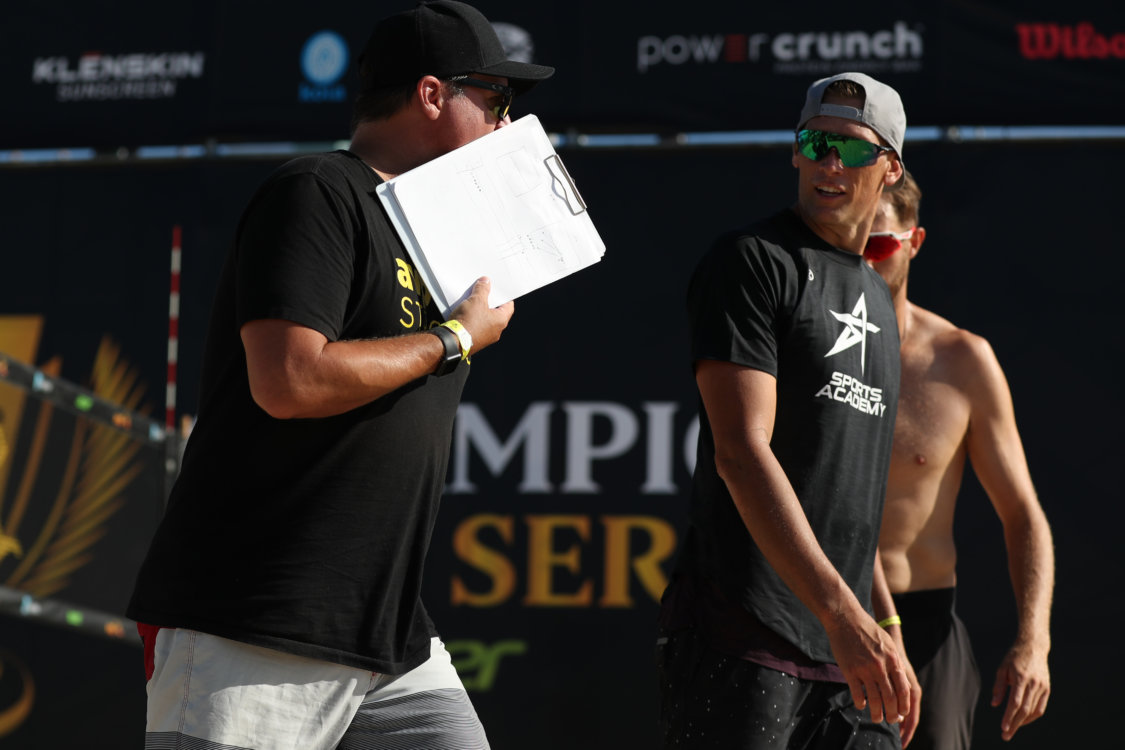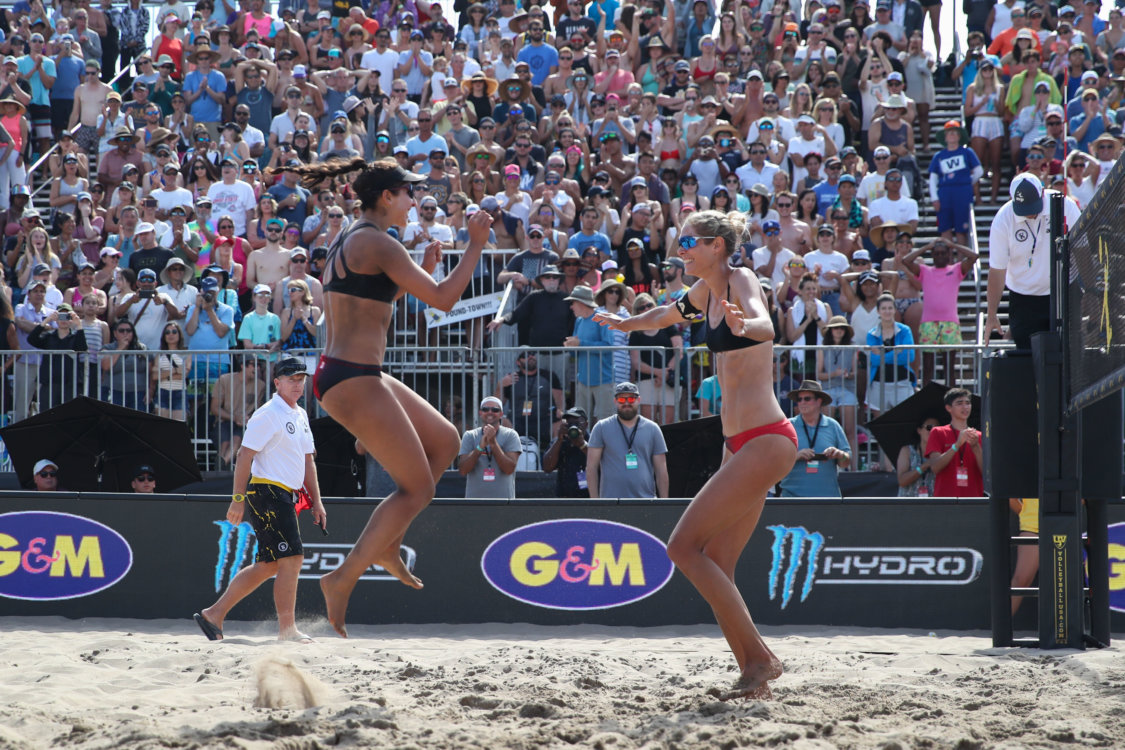 Scott Davenport is considered by many to be one of the best coaches in the world. His players have included Nick Lucena, Brooke Niles, Lauren Fendrick, Matt Fuerbringer, Ryan Doherty, Theo Brunner, and Casey Patterson. Oh, and the reigning World Champions and Olympic medal hopefuls Sarah Pavan and Melissa Humana-Paredes.
Scott Davenport is considered by many to be one of the best coaches in the world. His players have included Nick Lucena, Brooke Niles, Lauren Fendrick, Matt Fuerbringer, Ryan Doherty, Theo Brunner, and Casey Patterson. Oh, and the reigning World Champions and Olympic medal hopefuls Sarah Pavan and Melissa Humana-Paredes.
Sarah and Mel have been working with Scott since their team’s inception in late 2016. He’d been Sarah’s coach for years, so when she and Melissa looked towards Tokyo 2020, they trusted Scott with the prestigious coaching role.
As it happens with many career opportunities, Scott started coaching on a whim. He played on the AVP and FIVB for over a decade while also coaching indoor at Cal State Dominguez Hills. In 2009, the twilight of his career, a few people started asking Scott to coach them on the sand. Before he knew it, he’d left indoor and was coaching beach full time. And getting really good. As I said, I know a lot of high-level players that think Scott is among the best, if not the best, in beach volleyball.
One thing that makes Scott so great is his mind for the game. He is always thinking angles, strategy, and fundamentals. A practice with Scott is packed with feedback and breaking down movements. For an experienced and cerebral player like Sarah Pavan, his approach is perfect. And for a once-newbie and extremely talented Melissa, Scott opened up the game and made Melissa really good really quickly.

Via Instagram @Saran_Pavan
There’s always a team behind every team. Whether that’s your mom encouraging you over the phone or an assembly of professionals in your corner, every AVP partnership takes a village. Sarah and Mel are no different. They have Scott, Sarah’s husband Adam, assistant coach Chris Flood, frequent practice player Alex Amylon, sport’s psychologist Dr. Lee Hancock, biomechanics and exercise guru Dr. Powers, chiropractor David Lee, and a slew of others in Canada. While all of these people are a part of Sarah and Mel’s success, Scott’s role is unrivaled.
So why did Sarah and Melissa pick him? What makes a good coach? What advances a team from seemingly great to actually great? I knew the answers encompassed much more than just training, so Scott and I focused more on the coaching-adjacent roles – the ones you don’t think of when you hear the word “coach.”
But before getting into the non-coaching, let’s start with the coaching. “We do pretty much what everyone does, but maybe a little different,” Scott says. “We plan out a quad – four years. We don’t just look at it like, ‘Hey, this is the year.’ We look at – in four years, where we want to be and how we’re gonna get there. One, two, three builds up, and we periodize our sports psych training, our on-court training, our in the gym training to all coincide and peak at the right time.”
Sports psych is a huge part of Team Canada. Scott recruited his good friend Dr. Lee Hancock from Dominguez Hills to work with the girls. “The sports psychology part of it is overlooked,” he says. “I integrate sports psychology immediately. There’s so much experiential information that has to happen before someone develops to a level where they learn how to win and overcome certain situations. If you can integrate someone into your team that tells you the information you need to manage those situations and also practice those in practice, that been-there-done-that feeling, when you get into the games, you’re not surprised. You’ve prepared for the moment, you’ll know how to manage it, go through your checklist.”
Dr. Lee’s involvement was incredibly helpful when Melissa was a burgeoning young player joining ranks with an experienced athlete like Sarah. “We created a pretty good dynamic that helped develop Melissa quickly from a young player with a lot of talent to a professional at the highest level,” Scott says. “That was a big learning experience for her. She’s done a great job with that, and growing and maturing as a person.” The brain game is half the battle, and Team Canada has the right squad seeing to it.
With Dr. Lee taking care of the mental game, Sarah’s husband Adam Schulz has taken on the cerebral part. He’s a self-proclaimed volley and computer nerd. He literally built a new data-tracking program to help Sarah, Melissa, and Scott scout opponents. “We spent a year and a half on the code,” Scott says, “making adjustments on what I wanted to see and the information I wanted to extract and, as a team, what would benefit us. He created the program, and we’ve been using it ever since.”
“We look at service patterns, percentages of what they’re doing,” Scott continues. “From there, we try to pull out tendencies based on approach patterns, set locations, and distances, and just try to steal a point or two. The girls watch four or five matches, too. We don’t have a lot of free time on the road. We eat, and then we go watch video, talk about it, eat again. Adam and I are nonstop watching video.” These film sessions and subsequent strategy meetings are their war planning, when the team prepares for battle and gets on the same page.
This marriage of preparation and raw talent is what makes good teams great. “Any top team is going to generate points because they’re good at what they do,” Scott says. “But the ability to have high-level thinking and instinctual players on the court with a lot of good information and a game plan helps a lot.” Scott’s focus on this balance and ability to communicate it to his athletes are what separates him as great among good, too.
The better prepared a team is, the less a coach has to instruct them during a match. Most sideline coaching isn’t technical – it’s more about what the other team is doing and how to stop them. Maybe a coach would say, “you’re dropping your elbow,” or, “you keep rushing your approach.” But for the most part, they’re telling you where you’re scoring points and where points are being scored on you. Coaches like Scott track opponent’s service and attack patterns; that stuff is hard to remember as a player. But once you see it drawn on paper, you feel like a mindreader. This is the heavy benefit of a coach in your box.
Along with the other massive alterations of 2020, the AVP coaching rules changed. I’ll be writing an article about them soon, but the gist is coaches are allowed to be more involved during matches. Before, coaches were only allowed to talk during timeouts. Now, they can coach their players anytime the ball is dead and can call timeouts. It’s a huge adjustment that only exists on the AVP, and it presents a whole new aspect to the game. “It didn’t affect Melissa as much as it affected Sarah,” Scott admits. “Normally, they’re doing their own thing out there. But with the new rules, Sarah thought it was kind of distracting.”
But as their team is apt to do, they adjusted brilliantly. By the third weekend in the Series, Sarah had grown accustomed to turning to Scott when she needed him and trusting herself the rest of the time. And Melissa looked to Scott for service location strategies that earned them a few extra points to win a close match. “I like the [new] rules a lot,” Scott says. “For me, to be able to give a new perspective or piece of information in real-time that might help, that’s going to be fantastic.”
During timeouts, Scott guides his athletes to what they already know. “We refocus on our game plan,” Scott says. “And if there’s an adjustment, I kinda get their brains on that. But also just remind them to take care of what we’re doing, and to stay true to the anchors of our team. Our girls are pretty calm; even if things are going bad, they believe they can turn it around.”
That’s a level of confidence that only exists in the big leagues. That’s what powers Sarah and Melissa to score 7 unanswered points after a timeout when they’re down 8-13 in the third. It’s the cool they have in the World Championships and MBO Finals. And that self-assuredness originates from a run-of-the-mill Monday-morning practice in Hermosa Beach with Melissa, Sarah, Scott, and their team behind the team.
